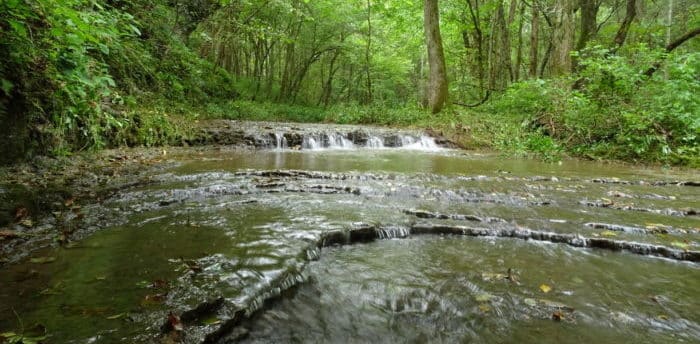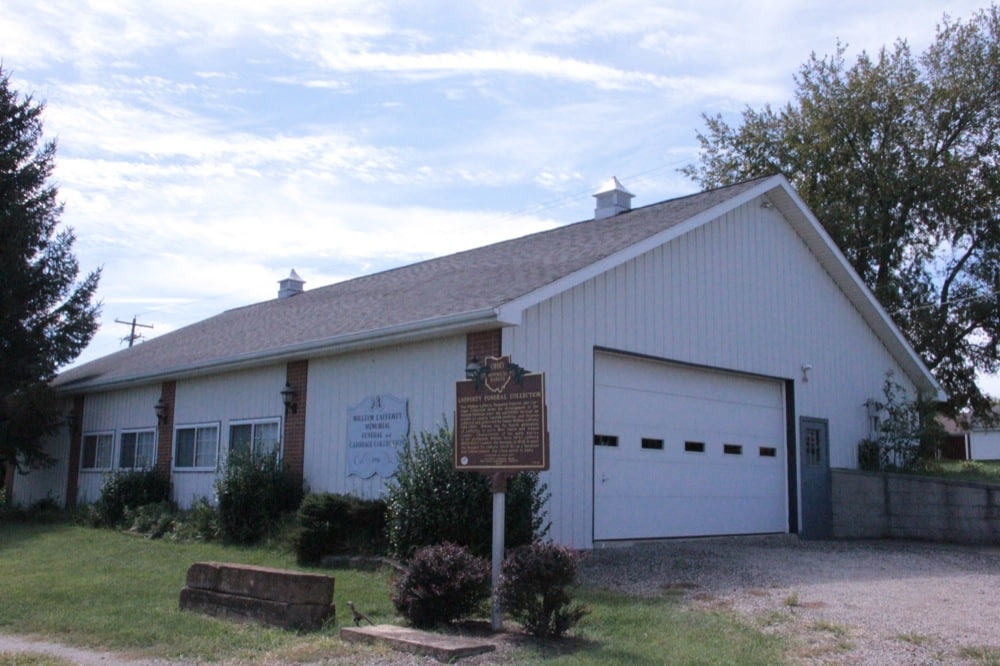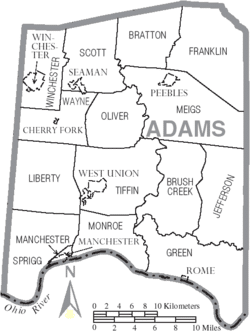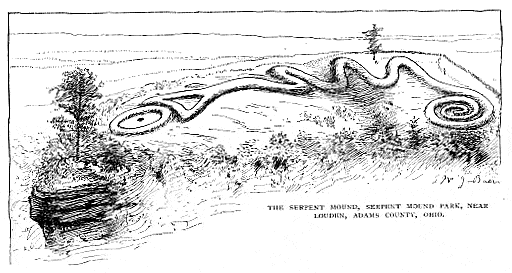This is my complete guide to Adams County Genealogy, Ancestry, and History.

Located on the southern border of Ohio and the banks of the Ohio River in Adams County. Adams County was founded by Arthur St. Clair on July 10, 1797, and was named after current President John Adams. It was originally part of the Northwest Territory and became the fourth county created in the area. In 1795, Nathanael Massie founded the first settlement in the county of Manchester.
Jump to:
Adams County: Local Historical Sites
Adams County Genealogical Society: A great resource for family researchers who have an ancestor who lived or traveled through Adams County, Ohio. If you are chasing a record in Adams County, then the local genealogical society would be a great place to start. They would most likely have the record or know where the record could be found.
Website: http://www.adamsctyohgen.org/
Adams County Paleo-Indian District: Adams County is known for its Paleo-Indian history, with its most notable historical site being The Great Serpent Mound. The address to the district is restricted but can be found around the Sandy Springs District. An excellent place to visit if you have an interest in the pre-historic natives that inhabited Ohio.
The Great Serpent Mound: The most popular historical attraction in Adams County is the Great Serpent Mound. This mound was built by the Paleo-Indians and is still maintained by the state of Ohio. The state park is a nice place to picnic, hike, and participate in many other outdoor activities.
Website: http://arcofappalachia.org/visit/serpent-mound/
John T. Wilson Homestead: Ohio played an important role in the Underground Railroad, and many of its towns have stories and houses that memorialize the path to freedom for slaves. The John T. Wilson Homestead is one of those and has been restored and preserved by the Ohio Underground Railroad Association.
Website: http://www.johntwilsonhomestead.org/
Wheat Ridge Old Thyme Herb Fair & Harvest Celebration: A bit of a mouthful but an excellent place to experience the culture of Adams County and the local community. There is a pumpkin cannon shooting, food and decorations made from scratch, and many other items that are unique to the local community
Edge of Appalachia Preserve System: A scenic preserve with many hiking trails. This preserve is at the edge of the Appalachian Mountains and is historic due to its location. Many Native Americans and pioneers have walked these trails and seen the sites that are on them.
Website: https://www.cincymuseum.org/nature
Shawnee State Forest: Another large preserve with multiple hiking trails. This state forest used to be the Shawnee Indian Tribe's hunting grounds. It is located along the border of Adams County and Scioto County.
Website: http://parks.ohiodnr.gov/shawnee
Ohio River Scenic Byway: The stretch of U.S. 52 through southern Adams County along the Ohio River is among the most scenic roads in Ohio. This rural highway winds past mountains and small communities with little or no industry along its way. Due to the importance of the Ohio River, this scenic highway runs through where many pioneers walked when settling the area.
Website: http://ohioriverbyway.com/
William Lafferty Memorial Funeral and Carriage Collection: It is odd, but it is still history. There are hearses for adults and one for children; an embalmer's buggy; a horse-drawn ambulance, a Brewster omnibus; and the first motorized ambulance used in Adams County, Ohio. These vehicles, along with other funeral items used by the Lafferty family since 1848, are on display at no fee.
Website: http://www.laffertyfuneralhome.com/home/funeral-museum/

Adams County: Geography

Adams County was created on July 10, 1797, from Hamilton County and Washington County and is now bordered by Highland County (north), Pike County (northeast), Scioto County (east), Lewis County, Kentucky (south), Mason County, Kentucky (southwest), Brown County (west).
Adams County Cities and Towns include:
- Cherry Fork
- Manchester
- Peebles
- Rome
- Seaman
- West Union
- Winchester
Adams County Townships include:
- Bratton
- Brush Creek
- Franklin
- Green
- Jefferson
- Liberty
- Manchester
- Meigs
- Monroe
- Oliver
- Scott
- Sprigg
- Tiffin
- Wayne
- Winchester
When researching an ancestor from Adams County, it would be beneficial to take a look at the county using Google Maps. It provides a perspective of the various rivers, significant buildings, cemeteries, townships, cities, churches, and other important areas that your ancestor may have left a trail.
- Adams County Clerk of Probate Court has Marriage Records from 1910 and Probate Records from 1849. The County Clerk of Probate Court handles the probating of wills, estate administrations, trusts, guardianships, adoptions, birth corrections, delayed birth registrations, and issues marriage licenses. The Probate Court is that the Probate Judge is the ex-officio Clerk of Courts; thus, the Court performs all the duties as its own Clerk of Courts.
- Adams County Recorder has Land Records from 1797. The County Recorder has the duty of keeping specific records, which may include deeds, mortgages, military discharges, plats, etc.
- Adams County Clerk of Court of Common Pleas has Court Records. The County Clerk of the Court of Common Pleas is responsible for duties that include filing, docketing, indexing, and preserving all court pleadings for civil, felony criminal, and domestic relations cases. Other services provided by the Clerk of the Court of Common Pleas are administering oaths, keeping naturalization records, and recording and retention of coroner records.
- The Adams County Health Department has Birth & Death Records from 1908-Present. For birth and death records prior to Dec. 20, 1908, contact the Probate Court of this county.
Adams County: Great Serpent Mound
The area has a rich history that involves Native Americans. Located in Adams County is the famous Great Serpent Mound. The Ohio History Connection maintains the location and says this about it:
Serpent Mound is a spectacular effigy earthwork of a serpent uncoiling along a prominent ridgetop in northern Adams County, Ohio. From the tip of its nose to the end of its tail, the effigy is 1,427 feet long. When it was originally described in 1848, the body of the serpent was five feet high and 25 feet wide.
Excavations between 1887 and 1889 by Frederic Putnam of Harvard University's Peabody Museum revealed the structure of the earthwork. But Putnam did not find any artifacts inside the mound that would reveal the age or cultural affiliation of the mound. Until recently, archaeologists assumed that the Serpent Mound was built by the Adena culture since two Adena burial mounds are located nearby. The Adena culture dates from between 800 B.C. and A.D. 100. However, there is also a Fort Ancient culture burial mound at the site. The Fort Ancient culture dates from between A.D. 1000 and A.D. 1650. Putnam also discovered traces of a village of the Fort Ancient culture overlying a smaller Adena site just south of the Serpent. Excavations into the Serpent in 1991 recovered charcoal that returned radiocarbon dates, suggesting that the Fort Ancient people built the mound between about A.D. 1025 and A.D. 1215.
Serpents are a common feature in the art of the Late Prehistoric Period (A.D. 900 C.E. to A.D. 1650). Many American Indians of the Eastern Woodlands believed the Great Serpent was a powerful spirit of the Underworld. Serpent Mound may be a representation of these beliefs...
The head of the Serpent Mound is aligned to the setting sun on the summer solstice, and the coils may be aligned to the summer and winter solstice and equinox sunrises. These alignments support the idea that the Serpent Mound had a ceremonial purpose.
Frederic Putnam saved the Serpent Mound from destruction. At his urging, funds were raised for Harvard University to purchase the site. The Peabody Museum converted the property into a public park and operated it as such until 1900 when it was deeded to the Ohio State Archaeological and Historical Society, now the Ohio History Connection. In 1908, an observation tower was built, and during the 1930s, a museum and other visitor facilities were added.
Serpent Mound is recognized as a National Historic Landmark. Serpent Mound State Memorial is located 20 miles south of Bainbridge in Adams County.

From the time of the American Revolutionary War to the time of the Civil War, the native Americans were pushed out west, and the area was settled by Americans pushing into the frontier and expanding their territory. Now Adams County is home to 28,105 residents, with its largest city being West Union (population 2,800). It is mostly a rural county and has been labeled predominately Republican.
Adams County Genealogy: Online Resources
- Federal Census Reports
- Ohio, Compiled Census and Census Substitutes Index 1790 - 1890
- U.S. Federal Census - 1880 Schedules of Defective, Dependent, and Delinquent Classes
- Adams County Genealogical Society
- Adams County Historical Society
- Manchester Historical Society
- Serpent Mound
- Ohio Historical Society, Archives-Library Division
- Ohio Genealogical Society
- The History Junkie's Guide to Ohio Genealogy
